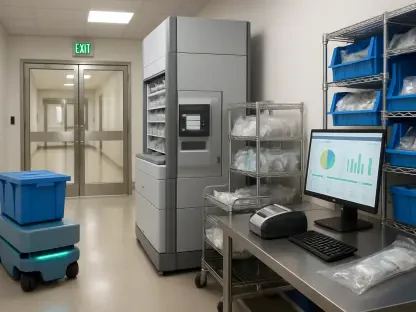The healthcare industry is undergoing a significant transformation driven by financial pressures and technological advancements. Financial uncertainty and strategic cost management remain critical as healthcare organizations navigate through various financial constraints. Meanwhile, integrating technology in healthcare has become essential for improving service delivery and operational efficiency. This article delves into these pivotal themes, exploring their impact on the modern healthcare landscape.
Financial Uncertainty and Strategic Cost Management
Healthcare organizations are grappling with financial pressures that demand astute cost management strategies. For instance, Walgreens and Kaiser Permanente have taken notable steps to mitigate financial uncertainty, highlighted by store closures and major sell-offs of private equity funds, respectively. These actions reveal an ongoing struggle to maintain liquidity and financial stability amidst increasing operational costs and fluctuating revenue streams. Financial constraints are driving these organizations to reevaluate their financial models and make difficult decisions to ensure long-term sustainability.Reimbursement and revenue cycle management are vital components in addressing financial challenges. Efficient revenue cycle management helps accelerate cash flow, which is crucial for maintaining the financial health of healthcare providers. Insurers’ significant rebate disbursements—such as the $1.1 billion expected this fall—underscore the continuous financial realignments in the sector, signaling shifts in how funds are managed and allocated. As costs continue to rise, effective reimbursement strategies and robust revenue cycle management will be paramount in securing the financial stability of healthcare organizations.Budgeting practices are equally pivotal. With healthcare costs on the rise, organizations must prioritize strategic planning and capital finance to sustain growth and service quality. Advanced financial models and robust budgeting protocols can help healthcare entities better forecast expenses and allocate resources efficiently. Strategic cost management not only assists in maintaining liquidity but also supports the long-term objectives of providing high-quality patient care. As financial pressures mount, healthcare organizations must adopt innovative financial strategies to navigate the complexities of the industry successfully.
The Role of Technology in Healthcare Management
Technology integration is reshaping healthcare management and service delivery. Clover Health’s initiative to extend its AI assistant to all Medicare Advantage payers and providers exemplifies how artificial intelligence is being harnessed to enhance operational efficiency. AI-driven tools can streamline administrative processes, reduce errors, and improve patient outcomes, illustrating the transformative potential of tech in healthcare. The adoption of AI and other advanced technologies is becoming increasingly critical as healthcare organizations strive to optimize their operations and deliver superior patient care.However, the tech landscape in healthcare is not without its challenges. The controversy surrounding healthcare chatbots disseminating racist misinformation highlights the ethical complexities of deploying AI solutions. Balancing technological innovation with ethical considerations is paramount to ensuring equitable and unbiased healthcare delivery. Ensuring that AI and other technological advancements serve the best interests of all patients requires ongoing vigilance and a commitment to ethical standards.Moreover, the criticality of digital administration is underscored by the challenges in risk adjustment coding and cybersecurity. Securing sensitive patient data while optimizing coding processes remains a priority as healthcare becomes increasingly digitized. Robust cybersecurity measures are essential in safeguarding against data breaches and ensuring compliance with regulatory standards. As healthcare organizations continue to digitize their operations, the importance of maintaining strong cybersecurity protocols cannot be overstated. The integration of technology in healthcare management brings with it both opportunities and challenges that must be carefully navigated to achieve optimal outcomes.
Provider-Payer Dynamics and Regulatory Impact
The dynamics between providers and payers are significantly influenced by regulatory frameworks. The Federal Trade Commission’s (FTC) rulings have sparked debate, reflecting the friction between hospitals, physicians, and regulatory bodies. These rulings often aim to foster competition and prevent anticompetitive practices, but they can also create tension within the healthcare ecosystem. As regulatory bodies continue to introduce new measures to ensure fair competition, healthcare providers and payers must navigate these changes to remain compliant and competitive in the market.Increased regulatory scrutiny is evident in the efforts of lawmakers to enforce stringent oversight of Medicare Advantage coverage decisions. Policymakers’ growing focus on coverage decisions aims to enhance accountability and ensure fair patient treatment. Such regulations are crucial in holding healthcare providers and insurers accountable, promoting transparency and better patient care. By aligning with regulatory expectations, healthcare organizations can build trust with patients and stakeholders, further enhancing their ability to deliver high-quality care.Compliance and legal matters in healthcare require continuous adaptation to evolving regulations. Healthcare organizations must stay abreast of legislative changes to avoid legal pitfalls and maintain operational integrity. Part of this involves regularly updating policies and procedures to align with new regulatory requirements. By proactively addressing compliance issues, healthcare providers can minimize risks and focus on delivering exceptional patient care. Navigating the complex landscape of provider-payer dynamics and regulatory impact remains a critical component of successful healthcare management.
Workforce Challenges and Social Impact
Healthcare workforce dynamics are evolving, influenced by societal and technological changes. Social media’s negative portrayal of the nursing profession has dissuaded potential entrants into the field, exacerbating the existing nursing shortage. This trend highlights the need for targeted initiatives to enhance the profession’s image and attract new talent. Addressing these challenges requires a multifaceted approach, including improving working conditions, offering competitive compensation, and promoting positive narratives about the healthcare profession.Innovative approaches are being adopted to support workforce resilience and accessibility. UPMC for You’s initiative to offer Medicaid re-determination coverage in laundromats exemplifies efforts to reach and engage underserved communities. Such strategies are crucial in fostering a motivated and well-supported healthcare workforce capable of meeting modern demands. By implementing creative solutions to workforce challenges, healthcare organizations can better support their employees and ensure a stable and competent workforce.The impact of social media and technological advancements on workforce dynamics cannot be overlooked. As healthcare roles and responsibilities evolve, ongoing education and support for healthcare professionals are essential to adapt to new technologies and maintain high standards of patient care. Providing training and professional development opportunities can help healthcare workers stay current with technological advancements and enhance their skill sets. As the healthcare industry continues to evolve, addressing workforce challenges and social impacts remains a top priority to ensure the sustainability and success of healthcare organizations.
Supply Chain Resiliency in Healthcare
The healthcare industry is undergoing a profound transformation, propelled by both financial pressures and technological advancements. Financial uncertainty looms large, compelling healthcare organizations to adopt strategic cost management practices to navigate through diverse financial constraints. Concurrently, the integration of technology in healthcare has transitioned from being optional to essential. Technological innovations are not just enhancing service delivery but also streamlining operational efficiency, making healthcare more accessible and effective. In addition to electronic health records and telemedicine, AI and machine learning are revolutionizing diagnostics and treatment plans. This comprehensive shift is reshaping how healthcare services are delivered and managed, compelling industry stakeholders to adapt rapidly. This article delves into these pivotal dynamics, examining the dual impact of financial challenges and technological integration on the contemporary healthcare landscape. Through this lens, it explores how these factors are collectively molding the future of healthcare, demanding a balanced approach to cost control and tech adoption.









